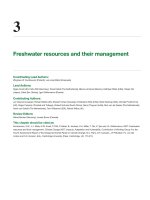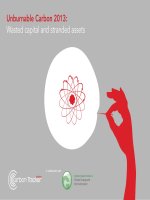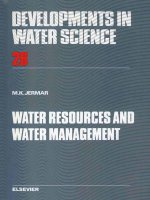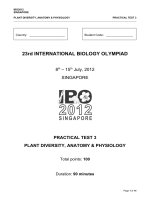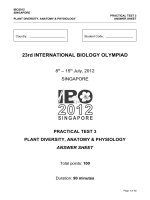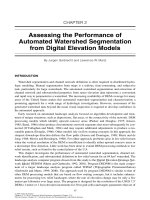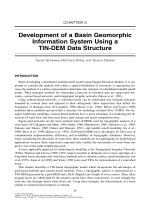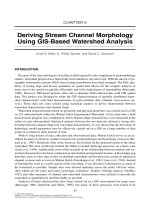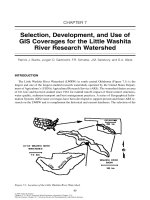PLANT ASSETS,NATURAL RESOURCES AND TANGIBLE ASSETS
Bạn đang xem bản rút gọn của tài liệu. Xem và tải ngay bản đầy đủ của tài liệu tại đây (1.76 MB, 57 trang )
Chapter 10
Chapter 10
Plant Assets, Natural
Resources, And
Intangible Assets
Financial Accounting, Sixth Edition
Chapter
10-1
Study Objectives
Study Objectives
1.
Describe how the cost principle applies to plant assets.
2.
Explain the concept of depreciation.
3.
Compute periodic depreciation using different methods.
4.
Describe the procedure for revising periodic depreciation.
5.
Distinguish between revenue and capital expenditures, and
explain the entries for each.
6.
Explain how to account for the disposal of a plant asset.
7.
Compute periodic depletion of natural resources.
8.
Explain the basic issues related to accounting for intangible
assets.
9.
Indicate how plant assets, natural resources, and intangible
assets are reported.
Chapter
10-2
Plant Assets, Natural Resources,
Plant Assets, Natural Resources,
and Intangible Assets
and Intangible Assets
Plant Assets
Plant Assets
Determining
the cost of
plant assets
Depreciation
Expenditures
during useful
life
Plant asset
disposals
Chapter
10-3
Natural
Natural
Resources
Resources
Intangible
Intangible
Assets
Assets
Depletion
Accounting for
intangibles
Research and
development
costs
Statement
Statement
Presentation
Presentation
and Analysis
and Analysis
Presentation
Analysis
Section 1 – Plant Assets
Section 1 – Plant Assets
Plant assets include land, land improvements, buildings,
and equipment (machinery, furniture, tools).
Major characteristics include:
“Used in operations” and not for resale.
Long-term in nature and usually depreciated.
Possess physical substance.
Referred to as property, plant, and equipment; plant and
equipment; and fixed assets.
Chapter
10-4
Determining the Cost of Plant Assets
Determining the Cost of Plant Assets
Land
Includes all costs to acquire land and ready it for use.
Costs typically include:
(1) the purchase price;
(2) closing costs, such as title and attorney’s fees;
(3) real estate brokers’ commissions;
(4) costs of grading, filling, draining, and clearing;
(5) assumption of any liens, mortgages, or
encumbrances on the property.
Chapter
10-5
SO 1 Describe how the cost principle applies to plant assets.
Determining the Cost of Plant Assets
Determining the Cost of Plant Assets
Land Improvements
Includes all expenditures necessary to make the
improvements ready for their intended use.
Examples are driveways, parking lots, fences,
landscaping, and underground sprinklers.
Limited useful lives.
Expense (depreciate) the cost of land
improvements over their useful lives.
Chapter
10-6
SO 1 Describe how the cost principle applies to plant assets.
Determining the Cost of Plant Assets
Determining the Cost of Plant Assets
Buildings
Includes all costs related directly to purchase or
construction.
Purchase costs:
Purchase price, closing costs (attorney’s fees, title
insurance, etc.) and real estate broker’s commission.
Remodeling and replacing or repairing the roof, floors,
electrical wiring, and plumbing.
Construction costs:
Chapter
10-7
Contract price plus payments for architects’ fees,
building permits, and excavation costs.
SO 1 Describe how the cost principle applies to plant assets.
Determining the Cost of Plant Assets
Determining the Cost of Plant Assets
E10-3 On March 1, 2008, Penner Company acquired real
estate on which it planned to construct a small office
building. The company paid $80,000 in cash. An old
warehouse on the property was razed at a cost of $8,600;
the salvaged materials were sold for $1,700. Additional
expenditures before construction began included $1,100
attorney’s fee for work concerning the land purchase, $5,000
real estate broker’s fee, $7,800 architect’s fee, and $14,000
to put in driveways and a parking lot.
Instructions
Determine amount to be reported as the cost of the land.
For each cost not used, indicate the account debited.
Chapter
10-8
SO 1 Describe how the cost principle applies to plant assets.
Determining the Cost of Plant Assets
Determining the Cost of Plant Assets
E10-3 Determine amount to be reported as the cost of the
land.
Land
Company paid $80,000 in cash.
$80,000
Old warehouse razed at a cost of $8,600
Salvaged materials were sold for $1,700.
8,600
- 1,700
Expenditures before construction began:
$1,100 attorney’s fee for work on land purchase.
$5,000 real estate broker’s fee.
$7,800 architect’s fee.
5,000
Building
Chapter
10-9
0
0
$14,000 for driveways and parking lot.
Land Improvements
1,100
Total
$93,000
SO 1 Describe how the cost principle applies to plant assets.
Determining the Cost of Plant Assets
Determining the Cost of Plant Assets
Equipment
Include all costs incurred in acquiring the equipment
and preparing it for use.
Costs typically include:
purchase price,
sales taxes,
freight and handling charges,
insurance on the equipment while in transit,
assembling and installation costs, and
costs of conducting trial runs.
Chapter
10-10
SO 1 Describe how the cost principle applies to plant assets.
Depreciation
Depreciation
Depreciation is the process of allocating the cost of
tangible assets to expense in a systematic and rational
manner to those periods expected to benefit from the
use of the asset.
Process of cost allocation, not asset valuation.
Applies to land improvements, buildings, and
equipment, not land.
Depreciable, because the revenue-producing
ability of asset will decline over the asset’s
useful life.
Chapter
10-11
SO 2 Explain the concept of depreciation.
Depreciation
Depreciation
Factors in Computing Depreciation
Cost
Chapter
10-12
Useful Life
Illustration 10-6
Salvage Value
SO 2 Explain the concept of depreciation.
Depreciation
Depreciation
Depreciation Methods
Objective is to select the method that best measures
an asset’s contribution to revenue over its useful life.
Examples include:
(1) Straight-line method.
(2) Units-of-Activity method.
(3) Declining-balance method.
Illustration 10-8
Use of depreciation
methods in 600 large
U.S. companies
Chapter
10-13
SO 3 Compute periodic depreciation using different methods.
Depreciation
Depreciation
Exercise (Depreciation Computations—Three Methods)
Parish Corporation purchased a new machine for its assembly
process on January 2, 2007. The cost of this machine was
$117,900. The company estimated that the machine would
have a salvage value of $12,900 at the end of its service life.
Its life is estimated at 5 years and its working hours are
estimated at 1,000 hours. Year-end is December 31.
Instructions: Compute the depreciation expense under the
following methods.
(a) Straight-Line.
(b) Units-of-Activity.
(c) Double-Declining Balance.
Chapter
10-14
SO 3 Compute periodic depreciation using different methods.
Depreciation
Depreciation
Straight-Line
Expense is same amount for each year.
Depreciable cost is
cost of the asset less
its salvage value.
Illustration 10-10
Straight-line method
predominates in
practice.
Chapter
10-15
SO 3 Compute periodic depreciation using different methods.
Depreciation
Depreciation
Exercise (Straight-Line Method)
Year
2007
2008
2009
2010
2011
Depreciable
Base
$ 105,000
105,000
105,000
105,000
105,000
/
/
/
/
/
Years
5
5
5
5
5
=
=
=
=
=
Annual
Expense
$ 21,000
21,000
21,000
21,000
21,000
$ 105,000
Accum.
Deprec.
$ 21,000
42,000
63,000
84,000
105,000
Journal entry 2007
Depreciation expense
Chapter
10-16
Accumulated depreciation
21,000
21,000
SO 3 Compute periodic depreciation using different methods.
Depreciation – Partial Year
Depreciation – Partial Year
Exercise (Straight-line Method)
Year
2007
Depreciable
Base
$ 105,000
/
2008
2009
2010
2011
2012
105,000
105,000
105,000
105,000
105,000
/
/
/
/
/
Years
5
=
5
5
5
5
5
=
=
=
=
=
Annual
Expense
$ 21,000
21,000
21,000
21,000
21,000
21,000
x
x
Partial
Year
3/12
9/12
=
=
Current
Year
Expense
$
5,250
21,000
21,000
21,000
21,000
15,750
$ 105,000
Accum.
Deprec.
$ 5,250
26,250
47,250
68,250
89,250
105,000
Journal entry:
2007
Depreciation expense
Accumultated depreciation
Chapter
10-17
5,250
5,250
SO 3 Compute periodic depreciation using different methods.
Depreciation
Depreciation
Units-of-Activity
Expense varies based on units of activity.
Depreciable cost is cost
less salvage value.
Illustration 10-12
Companies estimate
total units of activity to
calculate depreciation
cost per unit.
Chapter
10-18
SO 3 Compute periodic depreciation using different methods.
Depreciation
Depreciation
Exercise (Units-of-Activity Method)
($105,000 / 1,000 hours = $105 per hour)
Year
2007
2008
2009
2010
2011
Chapter
10-19
Hours
Used
200
150
250
300
100
1,000
x
x
x
x
x
Rate per
Hour
$105 =
105 =
105 =
105 =
105 =
Annual
Expense
$ 21,000
15,750
26,250
31,500
10,500
$ 105,000
Accum.
Deprec.
$ 21,000
36,750
63,000
94,500
105,000
SO 3 Compute periodic depreciation using different methods.
Depreciation – Partial Year
Depreciation – Partial Year
Exercise (Units-of-Activity Method)
Chapter
10-20
SO 3 Compute periodic depreciation using different methods.
Depreciation
Depreciation
Double-Declining-Balance
Decreasing annual depreciation expense over the
asset’s useful life.
Illustration 10-14
Declining-balance rate
is double the straightline rate.
Rate applied to book
value (cost less
accumulated
depreciation).
Chapter
10-21
SO 3 Compute periodic depreciation using different methods.
Depreciation
Depreciation
Exercise (Double-Declining Balance Method)
Year
2007
2008
2009
$ 117,900
70,740
42,444
x
x
x
40%
40%
40%
=
=
=
$ 47,160
28,296
16,978
$ 47,160
75,456
92,434
2010
2011
Chapter
10-22
Net
Bookvalue
Rate per
Year
Annual
Expense
Accum.
Deprec.
25,466
15,280
x
x
40%
40%
=
=
10,186
2,380
$105,000
102,620
105,000
Plug
SO 3 Compute periodic depreciation using different methods.
Depreciation – Partial Year
Depreciation – Partial Year
Exercise (Double-Declining Balance Method)
Chapter
10-23
SO 3 Compute periodic depreciation using different methods.
Depreciation
Depreciation
Illustration 10-16
Comparison of
Depreciation Methods
Annual Expense
Chapter
10-24
SO 3 Compute periodic depreciation using different methods.
Depreciation
Depreciation
Depreciation and Income Taxes
IRS does not require taxpayer to use the same
depreciation method on the tax return that is used in
preparing financial statements.
IRS requires the Modified Accelerated Cost
Recovery System, which is NOT acceptable under
GAAP.
Chapter
10-25
SO 3 Compute periodic depreciation using different methods.

